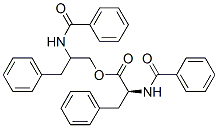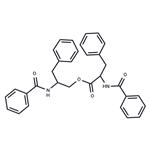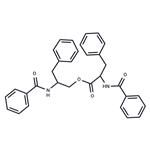Description
Asperphenamate is a fungal secondary metabolite originally isolated from
A. flavipes. It inhibits proliferation of T47D and MDA-MB-231 breast and HL-60 leukemia cancer cell lines (IC
50s = 92.3, 96.5, and 97.9 μM, respectively) and inhibits yeast α-glucosidase activity (IC
50 = 8.3 μM).
Uses
Asperphenamate is an α-glucosidase inhibitor isolated from Penicillium spathulatum. Asperphenamate exhibits anticancer properties and is used to synthesize N-Benzoyl-O-(N''-(1-benzyloxycarbonyl-4-piperidiylcarbonyl)-D-phenylalanyl)-D-phenylalaninol (BBP), an asperphenamate derivative that inhibits human breast carcinoma MCF-7 cell growth.
Definition
ChEBI: Asperphenamate is a carboxylic ester resulting from the formal condensation of the carboxy group of N-benzoyl-L-phenylalanine with the hydroxy group of N-benzoyl-L-phenylalaninol. A metabolite found in several Pencillium and Aspergillus species, as well as in plants as a product of endophytic fungi. It has a role as an antineoplastic agent. It is a L-phenylalanine derivative, a member of benzamides and a carboxylic ester. It is functionally related to a N-benzoyl-L-phenylalanine and a N-benzoyl-L-phenylalaninol.


